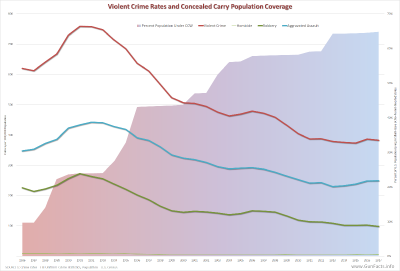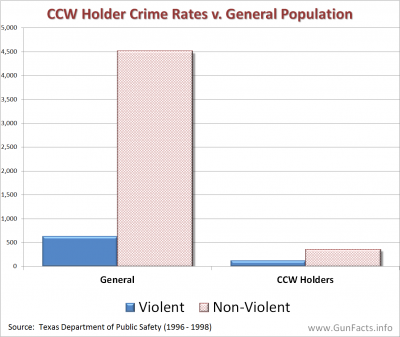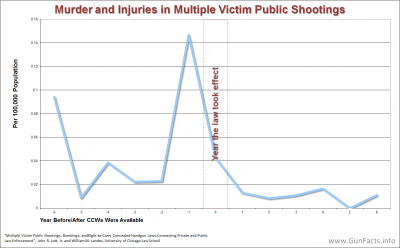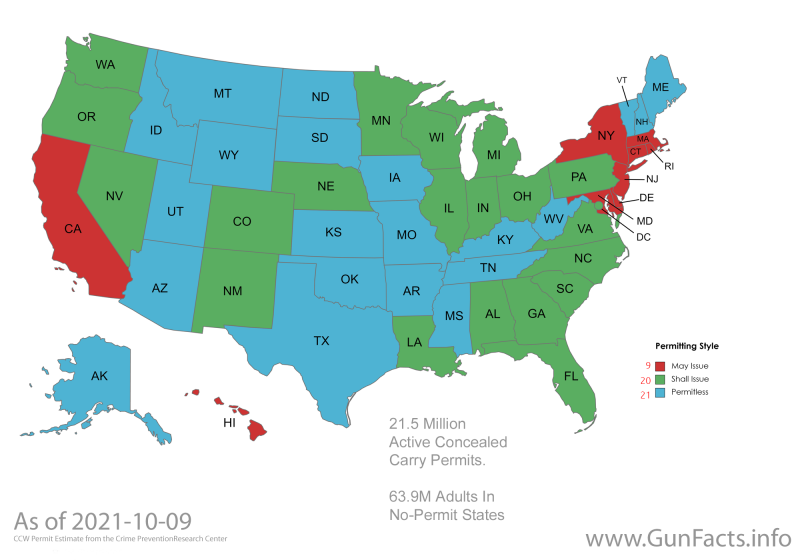Concealed Carry US States
From www.GunFacts.com
Myth: Concealed carry doesn’t prevent crimes
Fact: News reports tell many stories of armed civilians preventing mass murder in public. A few selected at random include:
- A citizen with a gun stopped a knife-wielding man as he began stabbing people in a Salt Lake City store.
- Two men retrieved firearms from their cars and stopped a mass murder at the Appalachian School of Law.
- Citizen takes out shooter while police were pinned down in Early, Texas.
- Citizen stops apartment shoot-up in Oklahoma City.
Fact: The FBI documents 1 that 3.2% of active shooter events were stopped by CCW holders. However, other researchers claim the FBI undercounts the number of incidents (e.g. excluding events that were precipitated by a grudge) and the on the high end the number is 16.5% 2.
Myth: Concealed carry laws increase crime
 Fact: Forty-two states, comprising the majority of the American population, are either “right-to-carry” states – where anyone without a criminal record will be issued a permit – or require no permit at all (though there are legal restrictions carrying weapons by felons, dometic abusers, etc.). In 1988 there were only ten “right-to-carry”. Statistics show that in these states the crime rate fell (or did not rise) after the right-to-carry law became active.
Fact: Forty-two states, comprising the majority of the American population, are either “right-to-carry” states – where anyone without a criminal record will be issued a permit – or require no permit at all (though there are legal restrictions carrying weapons by felons, dometic abusers, etc.). In 1988 there were only ten “right-to-carry”. Statistics show that in these states the crime rate fell (or did not rise) after the right-to-carry law became active.
Fact: Gun homicides were 10% higher in states with restrictive CCW laws, according to a study spanning 1980-2009. 3
Fact: Crime rates involving gun owners with carry licenses have consistently been about 0.02% of all carry permit holders since Florida’s right-to-carry law started in 1988. 4
Fact: After passing their concealed carry law, Florida’s homicide rate fell from 36% above the national average to 4% below. 5
Fact: In Texas, murder rates fell 50% faster than the national average in the year after their concealed carry law passed. Rape rates fell 93% faster in the first year after enactment, and 500% faster in the second. 6 Assaults fell 250% faster in the second year. 7
Fact: Crime is significantly higher in states without right-to-carry laws. 8
| Type of Crime |
% Higher in Restrictive States |
|---|---|
| Robbery | 105% |
| Murder | 86% |
| Assault | 82% |
| Violent Crime | 81% |
| Auto Theft | 60% |
| Rape | 25% |
Fact: States that disallow concealed carry have violent crime rates 11% higher than national averages. 9
Fact: Deaths and injuries from mass public shootings fall dramatically after right-to-carry concealed handgun laws are enacted. Between 1977 and 1995, 10 the average death rate from mass shootings plummeted by up to 91% after such laws went into effect, and injuries dropped by over 80%. 11
Myth: Right-To-Carry laws increase violent crime 13-15%
Fact: This rather miserable working paper is a wellspring of bad methodology, which might explain why it was not (as of July 2017) published in a peer reviewed journal.
Myth: Concealed carry permit holders shoot police
Fact: The Violence Policy Center started listing instances of CCW holders shooting police. 12 From May 2007 through November 2009 (2.5 years) they recorded nine police deaths, three in one mass killing by a white supremacist using an AK-47 rifle. Of the nine, five had yet to be tried or convicted as of the date of their report.
Myth: People with concealed weapons licenses will commit crimes
| State 13 | Licenses issued | Revoked licenses | % Revoked | Violent Crime Rate Change 14 |
|---|---|---|---|---|
| Florida | 1,327,321 15 | 4,129 | 0.3% | -30.5% |
| Virginia | 50,000 16 | 0 | 0.0% | -21.9% |
| Arizona | 63,000 17 | 50 | 0.9% | -28.7% |
| North Carolina | 59,597 18 | 1,274 | 1.2% | -26.4% |
| Minnesota |
46,636 19 |
12 | 0.03% | 8.0% 20 |
| Michigan | 155,000 21 | 2,178 | 0.1% | 1.4% |
Fact: The results for the first 30 states that passed “shall-issue” laws for concealed carry licenses are similar.
Fact: In Texas, citizens with concealed carry licenses are 14 times less likely to commit a crime. They are also five times less likely to commit a violent crime. 22
Fact: People with concealed carry licenses are: 23
- 5.7 times less likely to be arrested for violent offenses than the general public
- 13.5 times less likely to be arrested for non-violent offenses than the general public
Fact: Even gun control organizations agree it is a non-problem. One said about Texas, “because there haven’t been Wild West shootouts in the streets”. 24
Fact: Of 14,000 CCW licensees in Oregon, only 4 (0.03%) were convicted of the criminal (not necessarily violent) use or possession of a firearm.
Fact: “I’m detecting that I’m eating a lot of crow on this issue … I think that says something, that we’ve gotten to this point in the year and in the third largest city in America there has not been a single charge against anyone that had anything to do with a concealed handgun.” 25
Fact: In Florida, a state that has allowed concealed carry since late 1987, you are twice as likely to be attacked by an alligator as by a person with a concealed carry permit. 26
Myth: 460 people have been killed by CCW permit holders
Fact: The “study” by gun control group Violence Policy Center covers a six year span, meaning that at worst there is an average of 76 shootings of all types per year, including justifiable homicides.
Fact: As of 2017, there are over 14,500,000 CCW holders, 27 meaning the worst case kill rate (justifiable or not) is 0.003% of all CCW holders.
Myth: Concealed guns in bars will cause violence
Fact: In Virginia, in the first year where CCW holders were allowed to carry in bars, the number of major crimes involving firearms at bars and restaurants statewide declined 5.2% The crimes that occurred during the law’s first year were relatively minor. 28
Myth: Texas CCW holders are arrested 66% more often
 Fact: Most arrests cited are not any form of violent crime (includes bounced checks or tax delinquency). 29
Fact: Most arrests cited are not any form of violent crime (includes bounced checks or tax delinquency). 29
Fact: The Violence Policy Center “study” only includes arrests, not convictions.
Fact: Many of these arrests in this premature VPC “study” came in the early years of Texas CCWs when the law was not understood by most of the law enforcement community or prosecutors.
Fact: Compared to the entire population, Texas CCW holders are about 7.6 times less likely to be arrested for a violent crime. 30 The numbers breakdown as follows:
- 214,000 CCW holders 31
- 526 (0.2%) felony arrests of CCW holders that have been adjudicated
- 100 (0.05%) felony convictions
Fact: A different study concludes that the four year violent crime arrest rate for CCW holders is 128 per 100,000. For the general population, it is 710 per 100,000. In other words, CCW holders are 5.5 times less likely to commit a violent crime. 32
Fact: “I lobbied against the law in 1993 and 1995 because I thought it would lead to wholesale armed conflict. That hasn’t happened. All the horror stories I thought would come to pass didn’t happen. No bogeyman. I think it’s worked out well, and that says good things about the citizens who have permits. I’m a convert.” 33
Fact: “It has impressed me how remarkably responsible the permit holders have been.” 34
Myth: CCWs will lead to mass public shootings
 Fact: Multiple victim public shootings drop in states that pass shall-issue CCW legislation. 35
Fact: Multiple victim public shootings drop in states that pass shall-issue CCW legislation. 35
Fact: CCW holders have prevented or curtailed mass public shootings – Pearl, Mississippi (Pearl Junior High School), Edinboro, Pennsylvania (Parker Middle School), Winnemucca, Nevada (Players Bar and Grill), Colorado Springs, Colorado (New Life Church).
Fact: Of all the alternatives to preventing mass public shootings, police officers believe that civilian concealed carry is the most effective.” 36
Myth: People do not need concealable weapons
Fact: In 80% of gun defenses, the defender used a concealable handgun. A quarter of the gun defenses occurred in places away from the defender’s home. 37
Fact: 77% of all violent crime occurs in public places. 38 This makes concealed carry necessary for almost all self-defense needs. But due to onerous laws forbidding concealed carry, only 26.8% of defensive gun uses occurred away from home. 39
Fact: Often, small weapons that are capable of being concealed are the only ones usable by people of small stature or with physical disabilities.
Fact: The average citizen doesn’t need a Sport Utility Vehicle, but driving one is arguably safer than driving other vehicles. Similarly, carrying a concealable gun makes the owner — and his or her community — safer by providing protection not otherwise available.
Fact: 56% of Americans say more concealed weapons would make country safer. 40 Millions of Americans have concealed carry permits, and this doesn’t include people who carry in states that do not require permits.
Myth: Police and prosecutors are against concealed carrying by citizens
Fact: In a survey of 15,000 officers, 91% said concealed carry should be permitted citizens “without question and without further restrictions.” 41
Fact: 66% of police chiefs believe that citizens carrying concealed firearms reduce rates of violent crime. 42
Fact: “All the horror stories I thought would come to pass didn’t happen …I think it’s worked out well, and that says good things about the citizens who have permits. I’m a convert.” 43
Fact: “I … [felt] that such legislation present[ed] a clear and present danger to law-abiding citizens by placing more handguns on our streets. Boy was I wrong. Our experience in Harris County, and indeed statewide, has proven my fears absolutely groundless.” 44
Fact: “Virginia has not turned into Dodge City. We have not seen a problem.” 45
Fact: “The concerns I had – with more guns on the street, folks may be more apt to square off against one another with weapons – we haven’t experienced that.” 46
Fact: “… to the best of my knowledge, we have not had an issue. I had expected there would be a lot more problems … But it has actually worked out.” 47
Fact: “Coming from California [where he was on the Los Angeles police force for 28 years], where it takes an act of Congress to get a concealed weapon permit, I got to Maine, where they give out lots of carrying concealed weapon permits, and I had a stack of CCW permits I was denying; that was my orientation. I changed my orientation real quick. Maine is one of the safest places in America. Clearly, suspects knew that good Americans were armed.” 48
Fact: Explain this to the Law Enforcement Alliance of America, Second Amendment Police Department, and Law Enforcement for the Preservation of the Second Amendment, all of whom support shall-issue concealed carry laws.
Notes:
-
Active Shooter Incidents in the United States (2014-2014 and 2016-2017), FBI
-
The Problem With the FBI’s ‘Active Shooter’ Data, Lott, Real Clear Politics, October 2018
-
An examination of the effects of concealed weapons laws and assault weapons bans on state-level murder rates, Applied Economics Letters, Vol 21, No. 4
-
Florida Department of Justice, 1998
-
Shall issue: the new wave of concealed handgun permit laws, Cramer C and Kopel D. Golden CO: Independence Institute Issue Paper. October 17, 1994
-
Some criminologist believe measuring first year change is shortsighted as it takes more than a year for permits to be issued, reach critical quantities, and for the criminally minded to recognize the new situation and avoid violent confrontations.
-
Bureau of Justice Statistics, online database, reviewing Texas and U.S. violent crime from 1995-2001.
-
Crime, Deterrence, and Right-to-Carry Concealed Handguns, Lott, John R., and Mustard, David B. J. of Legal Studies, vol.26, n.1, pp.1-68 (Jan. 1997): This study involved county level crime statistics from all 3,054 counties in the U.S., from 1977 through 1992. During this time ten states adopted right-to-carry laws. It is estimated that if all states had adopted right-to-carry laws, in 1992 the US would have avoided 1,400 murders, 4,200 rapes, 12,000 robberies, 60,000 aggravated assaults – and saved over $5,000,000,000 in victim expenses.
-
FBI, Uniform Crime Reports, 2004 – excludes Hawaii and Rhode Island – small populations and geographic isolation create other determinants to violent crime.
-
Federal legislation created a national “gun-free schools” policy, effective in 1996. Some criminologists maintain this created a new dynamic, encouraging mass murder on campus. Thus, after 1995 it is increasingly difficult to make comparisons based on the effects of CCWs and mass shootings.
-
Multiple Victim Public Shootings, Bombings, and Right-to-Carry Concealed Handgun Laws: Contrasting Private and Public Law Enforcement, John Lott and William Landes, Law School of the University of Chicago, Law & Economics Working Paper No. 73
-
Law Enforcement Officers Killed by Concealed Handgun Permit Holders, VPC, December 13, 2009
-
Reports were as received. No selection or filtering process was used.
-
Violent crime rates are from inception of “shall issue” CCW through 2006, the most recent period available through the Bureau of Justice Statistics online database.
-
October 1987 through Jan 2008
-
1995 – no follow-up data available at time of collection
-
1994 through 2007
-
1995 through 2004
-
2002 through 2006
-
In 2005 and 2006, Minnesota had an abnormal spike in robbery and aggravated assaults. The first three years of CCW in Minnesota saw violent crime rates being roughly stable and the problem has somewhat abated since then.
-
2001 through 2007
-
Texas Department of Public Safety and the U.S. Census Bureau, reported in San Antonio Express-News, September, 2000
-
An Analysis of the Arrest Rate of Texas Concealed Carry Handgun License Holders as Compared to the Arrest Rate of the Entire Texas Population, William E. Sturdevant, September 11, 1999
-
Nina Butts, Texans Against Gun Violence, Dallas Morning News, August 10, 2000
-
John Holmes, Harris County [Houston, TX] District Attorney, In Session: Handgun Law’s First Year Belies Fears of ‘Blood in the Streets,” Texas Lawyer, December 9, 1996
-
Concealed Weapons/Firearms License Statistical Report, Florida Department of State, 1998 – Florida Game and Fresh Water Fish Commission, December 1998
-
State-by-state tally from licensing records conducted by Crime Prevention research Center
-
Gun Crimes Drop at Virginia Bars And Restaurants, Richmond Times-Dispatch, August 14, 2011, reporting data from the Virginia State Police
-
Basis For Revocation Or Suspension Of Texas Concealed, Texas Department of Public Safety, December 1, 1998
-
Texas Department of Corrections data, 1996-2000, compiled by the Texas State Rifle Association, www.tsra.com
-
These are year 2000 records. As of 2014, the number of Texas concealed carry license holders was 825,957.
-
An Analysis Of The Arrest Rate Of Texas Concealed Handgun License Holders As Compared To The Arrest Rate Of The Entire Texas Population, William E. Sturdevant, PE, September 11, 1999
-
Glenn White, President of the Dallas Police Association, Dallas Morning News, December 23, 1997
-
Colonel James Wilson, Director Texas Department of Public Safety, Dallas Morning News, June 11, 1996
-
Multiple Victim Public Shootings, Bombings, and Right-to-Carry Concealed Handgun Laws: Contrasting Private and Public Law Enforcement, Lott John R., Landes William M.; University of Chicago — Covers years 1977 to 1995
-
Gun Policy & Law Enforcement, PoliceOne, March 2013
- Armed Resistance to Crime: The Prevalence and Nature of Self-Defense with a Gun, by Gary Kleck and Marc Gertz, in The Journal of Criminal Law & Criminology, Northwestern University School of Law, Volume 86, Number 1, Fall, 1995 1
-
Criminal Victimization in the United States, U.S. Bureau of Justice Statistics, 1993
-
Kleck and Gertz, National Self Defense Survey, 1995
-
Majority Say More Concealed Weapons Would Make U.S. Safer, Gallup Poll, October, 2015
-
Gun Policy & Law Enforcement, PoliceOne, arch 2013
-
National Association of Chiefs of Police, 17th Annual National Survey of Police Chiefs & Sheriffs, 2005
-
Glenn White, president, Dallas Police Association, Dallas Morning News, December 23, 1997
-
John B. Holmes, Harris County Texas district attorney, Dallas Morning News, December 23, 1997
-
Jerry Kilgore, Virginia Public Safety Secretary, Fredricksburg Freelance Star, February 2, 1996
-
Chief Dennis Nowicki, Charlotte-Mecklenburg North Carolina Police, News and Observer, November 24, 1997
-
Lt. William Burgess of the Calhoun County (Michigan) Sheriff Department, Battle Creek Enquirer, January 28, 2005
-
Detroit Police Chief James Craig, Detroit police chief: Legal gun owners can deter crime, The Detroit News, January 3, 2014
© 1998-2021, Guy Smith. Source: http://www.gunfacts.info/gun-control-myths/concealed-carry/#return-note-91-13



